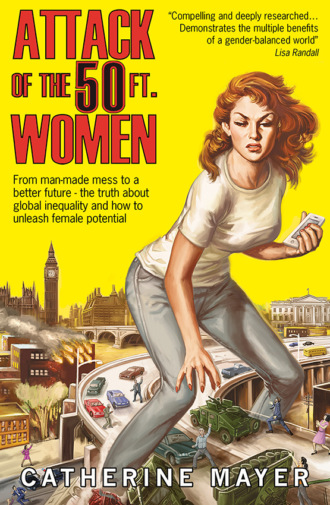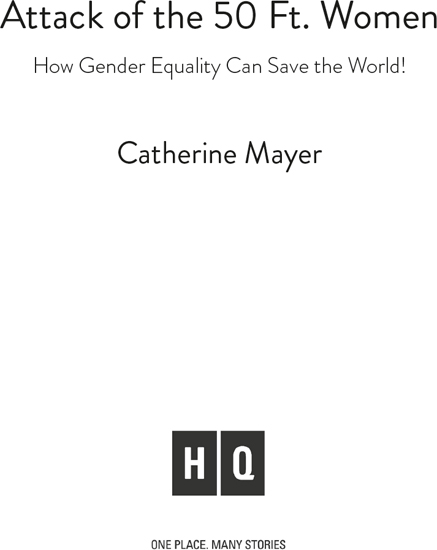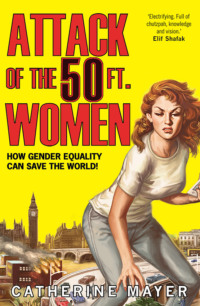
Полная версия
Attack of the 50 Ft. Women: From man-made mess to a better future – the truth about global inequality and how to unleash female potential


To sisters, mine especially.
And in memory of Sara Burns, Sarah Smith, Michael Elliott and Ed Victor.
BY THE SAME AUTHOR
Charles: The Heart of a King
Amortality: The Perils and Pleasures of Living Agelessly
Epigraph
If we were socially ambisexual, if men and women were completely and genuinely equal in their social roles, equal legally and economically, equal in freedom, in responsibility, and in ‘self esteem’, then society would be a very different thing. What our problems might be, God knows. I only know we would have them. But it seems likely that our central problem would not be the one it is now: the problem of exploitation – exploitation of the woman, of the weak, of the earth.
URSULA LE GUIN
‘Is Gender Necessary?’, The Language of the Night: Essays on Fantasy and Science Fiction, 1976.
Contents
Cover
Title Page
Dedication
BY THE SAME AUTHOR
Epigraph
Introduction: The Shoulders of Giants
Chapter One: Gate-crashing the club
Chapter Two: Votes for women
Chapter Three: All womankind
Chapter Four: Being a man
Chapter Five: Home economics
Chapter Six: What really shocks me
Chapter Seven: Frozen out
Chapter Eight: This should be everyone’s business
Chapter Nine: Unbelievable
Chapter Ten: Adam and Eve and Apple
Chapter Eleven: Winter wonderland
Chapter Twelve: Equalia welcomes carefree drivers
Acknowledgements
Notes and References
Select Bibliography
Copyright
Introduction: The Shoulders of Giants
A COLOSSAL ZOMBIE Scarlett Johansson commandeered London’s red buses a few years ago. She sprawled across the upper deck of a fleet of vehicles, face slack with simulated desire, mouth gaping wide enough to swallow a small terrier, breasts threatening to smother passengers seated in the lower tier.
Dolce & Gabbana’s advertising campaign intended to evoke Marilyn Monroe’s heyday, and it succeeded. The apparition recalled Nancy, the title character of a 1958 film, Attack of the 50 Ft. Woman. Nancy’s encounter with a space alien transforms her into a giant (‘Incredibly Huge, with Incredible Desires for Love and Vengeance’). The patriarchal authorities – doctors, police, spouse – chain her, but she breaks free and, naked but for an arrangement of bed sheets, embarks on a murderous rampage. Behold the dreadful power of woman unleashed (‘The Most Grotesque Monstrosity of All’)!
Zombie Johansson captured the inadvertent humour of the B-movie, but she was properly scary too. In her human incarnation she is the only woman to break through Hollywood’s diamond ceiling to claim a place among the ten top-grossing actors of all time. She chooses intelligent roles and has more than once pushed back against the chauvinism of Hollywood and its media ecosystems. Her dead-eyed alter ego belonged to the monstrous regiment of billboard women in perpetual march across the world. Nancy gained agency as she grew. Today’s 50-footers, hypersexualised and supine, promote a retrograde ideology alongside brands and products.
We’re so marinated in this imagery that we seldom stand back to parse its meaning and impact. It is all-pervasive, not just on hoardings and print and broadcast but metastasised into myriad digital forms. The underlying messaging is little different to the drumbeat that helped return women to pliant domesticity after World War II. From earliest childhood, girls are taught to value themselves for their abilities: desirability, marriageability, tractability.
There are, of course, other role models, women of stature and astonishing achievement, but still they break through against the odds. Globally women own less and earn less than men, often in the worst and worst regulated jobs, undertake the lionesses’ share of caregiving and unpaid domestic labour, and are subject to discrimination, harassment and sexual violence.
Every woman navigates a world fashioned by and for men. Some pharmaceuticals fail us because they are tested on male animals to avoid having to account for hormonal cycles. We shiver at our workplaces because thermostats are set to temperatures that suit male metabolisms.
We’re left in the cold in other ways too. The Organisation for European Economic Co-operation (OEEC) logs the gap between women’s earnings and men’s at 17.48 per cent in the UK, 17.91 per cent in the US and 18 per cent in Australia. Women have long been blamed for this gap. We don’t ask for raises often enough or we don’t ask right. Studies identify the real culprits: job segregation and discrimination.1
Jobs traditionally performed by men attract higher wages than those held by women. The paradigm of the husband as the head of the household remains firmly lodged in the public imagination. One reason some employers pay men better may be that they think the men have greater need of the money. In the US, men in nursing are vastly outnumbered by their female colleagues, by nine to one, yet earn $5,100 more on average per year than female nurses.2 These disparities are echoed across the world.
Every woman lives with the constant tinnitus hum of low-level sexism. Most of us have been leered at or leched over and told we should be flattered by the attention. Almost a fifth of US women will be raped in their lifetimes, with close to half reporting other forms of sexual violence. One in three women worldwide will be subjected to violent sexual attack.3 The response to this epidemic is muted and muddled.
US prosecutors ask a judge to send a college athlete to prison for six years for sexually assaulting an unconscious woman; the judge decides on six months, concerned a longer period of incarceration will have a ‘severe impact’ on the perpetrator. He is freed halfway through his sentence. In India, a woman is gang-raped to death; one of her rapists says: ‘A decent girl won’t roam around at nine o’clock at night. A girl is far more responsible for rape than a boy.’ The majority of the 276 schoolgirls kidnapped by terrorists in northern Nigeria are still missing; those who escape bearing tales of mass rape and slavery find themselves social outcasts. Egyptian lawmakers finally approve a draft bill that would dole out five- to seven-year jail terms for people carrying out female genital mutilation (FGM), an operation to remove part or all of the clitoris. The procedure – often called circumcision by those trying to minimise its brutality – has been inflicted on more than 90 per cent of the country’s women and girls. ‘We are a population whose men suffer from sexual weakness, which is evident because Egypt is among the biggest consumers of sexual stimulants,’ an MP protests. ‘If we stopped circumcising we will need strong men, and we don’t have those.’4 Up to 1,000 women are sexually assaulted on the streets of the German cathedral city of Cologne on New Year’s Eve 2015; the attacks trigger condemnation not of women’s oppression but of migration, reinforcing the false narrative that sexual violence is imported, rather than native to white European society.
And on 8 November 2016, US voters choose their President. The front-runners are a female candidate and a man who has been recorded boasting of assaulting women. ‘Grab them by the pussy. You can do anything,’ he says.5 After the recording emerges, ten women come forward to accuse him of assault. He insists that they are lying. After all, two of them were too ugly to grope.
Many other aspects of his candidacy should also repel any voter who values equality. The candidate appears to believe only in himself, but panders to Christian social conservatives by promising to roll back women’s reproductive rights. He pledges to ban Muslims from the country and force Mexico to build a wall to keep its own citizens from crossing the border into the US. He refuses to condemn his supporters for racist violence.6 He publicly invites the Russian secret service to hack US government emails to damage his opponent and announces he will unpick years of international negotiations to limit climate change – which he calls a ‘hoax’.
He is the worst would-be President we have seen in our lifetimes or read about in history books – dangerous, incoherent and vain.
He wins the election.
A majority of men votes for him, by 53 per cent to 41 per cent.
A majority of white people votes for him, by 58 per cent to 37 per cent.
Eighty-one per cent of white evangelicals and born-again Christians vote for him.
Women vote against him, by 54 per cent to 42 per cent. Yet a majority of white women supports him: 53 per cent.7
A dual US and UK national, I cast a ballot in my home state of Wisconsin. I am not one of the white women who helped Donald Trump into the White House, but like all white American women, I am implicated. Through researching this book, I also understand the mechanisms that encourage turkeys to vote for Christmas.
This book aims to set out those insights and to make something else abundantly clear. The skewed status quo serves almost nobody – certainly not most men.
The world is full of decent men who strive to be allies to women. It’s a safe bet that most men who are engaged enough in these issues to read these pages fall into this category, though you may not always be sure how best to support us. Many of you want change, for women and girls and for yourselves, but you don’t always understand that ‘women’s issues’ are your issues. You observe your own sex suffering within patriarchal cultures and structures but don’t always join the dots. Because of these structures, boys struggle at school; suicide rates are highest among young males, who are also more likely to murder and more likely to be murdered; and men drink more heavily and more frequently end up in prison. Fathers yearn to be with their children, but the enduring pay gap means they cannot afford to stay home, while social norms sometimes deter them from pushing for change. Businesses, institutions and economies underperform.
The twenty-first century wasn’t supposed to be like this.
Late boomers like me grew up believing history was going our way. We assumed progress to be linear, counting ourselves lucky to be born to an era that had all but vanquished the great scourges of humanity. Racism and homophobia proved susceptible to education and so would wither. Wars were still prosecuted, but at a distance. Hunger, too, seemed confined to far-away lands, and technology must surely deliver fixes, just as it would soon banish cancer, ageing, death and clothes moths. As for women’s rights, the heavy lifting had been done by the women, and their male allies, who came before us. A liberal consensus held sway and growing up in comfort, largely surrounded by the white middle classes, I had no idea of the limits or vulnerabilities of our progress.
After a peripatetic early childhood, I attended a girls’ school in Northern England that proudly counted among its alumnae all three daughters of the magnificent, if flawed, Emmeline Pankhurst. We learned that the Suffragettes’ achievements marked the beginning of the end of the gender wars. In 1918, as Europe made its fragile peace, the Representation of the People Act granted some British women the right to vote. A decade later that right was extended to all adult females. New Zealand had led the way in 1893. The US followed suit in 1920. When I was seven and still living in the US, the doughty women of Ford Dagenham fought and won the battle for equal pay. Women’s libbers and the Pill were finishing the job. As teenagers my contemporaries and I saw shimmering on the near horizon a fully gender-equal society in which every inhabitant could stand as tall as the next person.
I named this place ‘Equalia’, and like a querulous child on a family outing, I’ve spent much of my life asking ‘When will we get there?’ There’s always someone prepared to claim we’ve already arrived. Such people rarely describe themselves as feminists because they misunderstand the term as a doctrine of suppression.
The media maintains lists of pundits who can be relied on to declare that Western women already have enough equality. After all, the largest and second-largest economies in Europe are run by women, and most Western countries have legislated for equal pay, even if the legislation hasn’t achieved the desired result. The laws and their application cannot be faulty; women must be choosing their lower status. Sex discrimination and sexual harassment are outlawed, so women must deserve this treatment. We never had it so good. We should stop whingeing and worry about Saudi Arabia. (It is axiomatic among these useful idiots that you cannot advocate for the rights of women in your own country and in Saudi Arabia.) Feminism can go home and put its feet up.
Broadcasters are particularly fond of pitting women against women. The anti-feminist female is as persistent a breed as the clothes moth. Typically white and middle class, she either doesn’t believe in gender equality or else she doesn’t believe in gender inequality – because she’s too cocooned and myopic to see it. She routinely seeks to strengthen her case by co-opting a tenet of feminism: that the personal is political. She feels no kinship with younger and less privileged women still fighting the old battles while simultaneously picking their way through new and dangerous territories. She declares that she has never experienced sexism or discriminatory behaviour she couldn’t handle. She is thriving.
Let us celebrate the advances that enable her complacency even as we sometimes doubt her sincerity. Her protests are too vigorous, her unease in her own skin too obvious. Her mind has hardened with habit into narrow pathways and she cannot conceive how her own discomfort might relate to a wider pattern. The men around her give succour to her views.
‘The war has been won,’ one such tells me. ‘It’s just a mopping up operation now. You can’t even kick your dog now much less your wife.’ Yet, make no mistake, we haven’t reached Equalia. The Most Grotesque Monstrosity of All? We’re still a long, long way from Equalia.
We live, wherever we live, under a patriarchy, a system that excludes women. Not a single country anywhere on the planet has attained parity. The Nordic quartet of Iceland, Norway, Finland and Sweden tops the rankings of the best places to be female. Even in these countries, though, girls start life as second-class citizens and will be demoted further down the unnatural order with every year beyond their socially determined prime, or if poor or non-white or disabled or daring to combine any of these factors.
There is increasing awareness that gender is not binary but a spectrum, yet this awareness has neither diminished gender conflict nor created acceptance for people transitioning along the spectrum or sitting at junctions that challenge bureaucratic or social labels. Groups that are themselves disadvantaged unconsciously incorporate patriarchal pecking orders. Gay men have a habit of crowding out the other letters in the LGBTQ movement. Civil rights activists have form too. In 1964, Stokely Carmichael, a leader of the Student Nonviolent Coordinating Committee, batted away a question about women volunteers. ‘The position for women in SNCC is prone,’ he said.8 It was, he later explained, a joke, but one that closely matched the experience of women in progressive movements. Black Lives Matter, founded by three women , Patrice Cullors, Alicia Garza and Opal Tometi, to illuminate the high – and under-reported – toll of racially motivated killings of black Americans by whites, focuses increasingly on the killings of black males by law enforcement officers. This is hugely important but killings of black women get less attention, prompting a separate movement to take up the cause, #SayHerName.
The elites that might be expected to forge solutions are themselves part of the problem. There is a startling lack of any kind of diversity in politics, and the gender imbalance is stark. Until 2017 there were more male MPs in the Westminster parliament than there had ever been female MPs elected. America blew its chance to finally elect a woman to the White House amid barbs about blow jobs. ‘Hillary sucks, but not like Monica’ read T-shirts and badges flaunted by Trump supporters. Bill Clinton dallied with White House intern Monica Lewinsky. Hillary Clinton, like Lewinsky, continues to be vilified for his actions. Sexism and misogyny were by no means the only drivers of her defeat, but they certainly played a part. Still, women had cause to celebrate the elections according to the US media outlets that trumpeted ‘the highest number of women of colour on record’ to win seats in the Senate. That record-breaking grand total equals just four: Catherine Cortez Masto, Tammy Duckworth, Kamala Harris and Mazie Hirono. The number of female representatives in both houses remained static at 104, a mere 19.4 per cent.
Business is just as bad. Among CEOs of the biggest companies in the UK and the US there are more men called John than women of any name. Financial institutions in both countries are overwhelmingly white, male and middle class. Other key institutions – the judiciary, the police, the media – share the same weaknesses.
Here’s something else they share: most of them claim, institutionally and individually, to support gender equality. The liberal consensus is still alive but it is under concerted attack from different expressions of political and religious extremism. The forces ranged against it aim not only to destroy it, but to dismantle its legacy of rights and protections. Progress is not, after all, linear, and it is far too easily reversed.
We would not have so much to lose if not for the achievements of feminism. Its Western incarnation loosely divides into four eras, or waves. The first, in the late nineteenth and early twentieth centuries, coalesced around the battle for votes for women. The second kindled in the 1960s, and asserted reproductive rights as a tool of liberation that would enable women to define their own being and sexuality and participate alongside men outside the home. It often rejected the possibility of equality within existing systems and structures. A third iteration in the 1990s grappled with the movement’s own failings to address systemic inequalities in its own ranks, while another strand attempted to seize ownership of male ideals of womanhood and recast them as female empowerment. The 1993 remake of Attack of the 50 Ft. Woman, starring Daryl Hannah, becomes a parable of emotional as well as physical growth, and gets a happy ending.
We’re now well into a fourth era, more of a torrent than a wave thanks to the proliferation of digital media, and too fast-flowing to analyse easily. It doesn’t help clarity that so many people lay claim to be part of that flow. Business leaders insist that finding and retaining female talent is essential to success. Economists hail increasing gender balance in the labour force as the key to growth. One recent report estimates a boost to global GDP of £8.3 trillion by 2025 simply by making faster progress towards narrowing the gender gap.9 Two large-scale pieces of research by Credit Suisse suggest that companies with significant numbers of women in decision-making roles are more profitable.10 Multiple studies also suggest that giving women a greater say – and a greater stake – in the planet is essential to building a healthier planet. Trump rushed to withdraw the US from the Paris accord, continuing to voice doubts about the reality of climate change. Among the rural poor, women don’t have the luxury of such doubts. They are at its sharp end, because females are most often tasked with sourcing water, food and energy for their families and communities. In 25 sub-Saharan countries, 71 per cent of the water collectors are women and girls who every day spend an estimated 16 million hours fetching water, compared to six million hours spent by men. The worse the drought, the longer the journeys and the greater the vulnerability of those women and girls. In India, 75 per cent of rural women work in agriculture but own only nine per cent of arable land. Bina Agarwal, Professor of Development Economics and Environment at the University of Manchester, posits that increased female participation in business decision-making improves environmental outcomes.11
Agarwal rejects the romantic idea that this is because women are in some way closer to nature than men, but much of the current orthodoxy identifies women as a corrective to testosterone-driven cultures. The Credit Suisse studies find companies steered by women take fewer risks. ‘Where women account for the majority in the top management, the businesses show superior sales growth, high cash-flow returns on investments and lower leverage,’ says the 2016 report.
Politicians of many stripes laud women and profess to fight for us. Congresswoman Ann Wagner went so far during the US election campaign as to call on her own party’s nominee to stand aside because of his misogyny. ‘As a strong and vocal advocate for victims of sex trafficking and assault, I must be true to those survivors and myself and condemn the predatory and reprehensible comments of Donald Trump,’ Wagner said in an October 2016 statement. Less than a week before polling day, she urged voters to back Trump, and has subsequently become an enthusiastic cheerleader for his dismantling of the Affordable Care Act, better known as Obamacare. Thirteen male Senators drafted Trump’s first attempt at a replacement bill, which restricted funding for Planned Parenthood and access to abortion insurance, and allows companies providing healthcare insurance to charge women more for ‘pre-existing conditions’. That might sound reasonable until you consider the conditions – pregnancy, Caesarian sections, post-natal depression, domestic violence, sexual assault and rape.
Wagner has been unlucky in one respect. Political commitment to gender equality is often little more than skin deep, but a great many politicians get away without their commitment being so publicly tested and found wanting. This is not to paint all politicians as hypocrites. Many of them believe in women. It’s just that when push comes to shove, they believe in other things more – and they also make the mistake I once did, of assuming that gender equality is already well on its way, without any extra help from them.
If there is a sliver of a silver lining to Trump’s victory, it is that it dented this myth. It did not destroy it. Clinton’s defeat seemed to contrast a regressive US with feminising cultures elsewhere. Patricia Scotland had recently taken office as the Commonwealth’s first female Secretary-General. Estonia had its first female president. Rome and Tokyo for the first time had elected female mayors. After a campaign dominated by male voices tore up the UK’s membership of the European Union and Prime Minister David Cameron stepped down, Britons wondered if women might save the day. Some looked with envy at Germany and its unflappable Chancellor Angela Merkel. More than a few English voters discovered a new reason to beg Scotland not to secede; they wanted the country’s clever First Minister Nicola Sturgeon to be Prime Minister of England too. Britain’s two biggest parties, the governing Conservatives and Labour opposition, turned hopeful eyes to senior women in their ranks. There was, after all, precedent. In 1979, the British economy seemed locked into a downward spiral of a weakening currency and blooming inflation, amid industrial unrest that saw even gravediggers down tools. Then a general election returned Margaret Thatcher to Downing Street, the first female Prime Minister not only of the UK but of any major industrial democracy. Within a few years, her economic policies had laid waste whole communities and sectors but galvanized other quarters and, more than that, revived a sense of potential that had long been missing.






